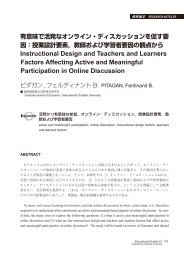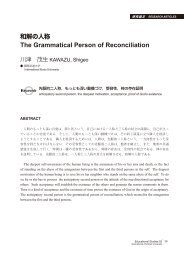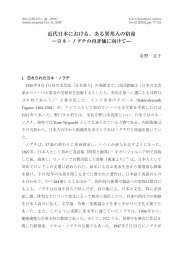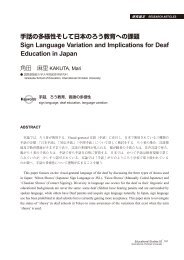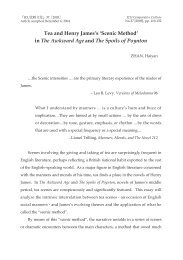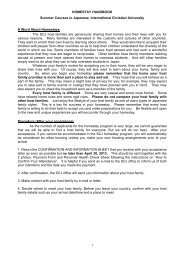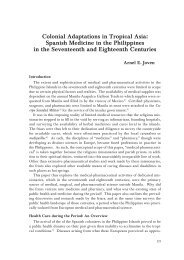Figure 1: The functional distribution <strong>of</strong> <strong>English</strong> <strong>in</strong> various doma<strong>in</strong>s from 700 to 1800(Görlach 2001, p.48)Approach 1. <strong>Incorporat<strong>in</strong>g</strong> language changeand language contactSmith states, “No liv<strong>in</strong>g language is unchang<strong>in</strong>g.”All languages are under <strong>the</strong> <strong>in</strong>fluence <strong>of</strong> o<strong>the</strong>rlanguages that <strong>the</strong>y have contact with. When newwords and expressions are borrowed or created basedon foreign elements, <strong>the</strong> new ones and <strong>the</strong> old onesexist side by side for a certa<strong>in</strong> period. Codificationand standardization, namely whe<strong>the</strong>r new forms willbecome part <strong>of</strong> <strong>the</strong> common language, depend onvarious factors.Crystal <strong>in</strong> his model <strong>of</strong> <strong>the</strong> <strong>English</strong> languagedemonstrates that every language has social,regional, temporal, and personal variations (Crystal,p. 3). Know<strong>in</strong>g not only its structure but alsoits use, Crystal asserts, is essential for thoroughunderstand<strong>in</strong>g <strong>of</strong> any language. The strong <strong>in</strong>terest<strong>in</strong> sociol<strong>in</strong>guistics and pragmatics nowadays<strong>in</strong>dicates that <strong>the</strong> amalgamation <strong>of</strong> synchronic anddiachronic phenomena will be beneficial especiallybecause language use is considered important <strong>in</strong>l<strong>in</strong>guistics today (Smith, pp.8-10). Analogy andreanalysis are good sources <strong>of</strong> <strong>in</strong>formation abouthow people formulate and utilize rules. Analogyand reanalysis are known to frequently occur <strong>in</strong> <strong>the</strong>children’s language acquisition process as well as <strong>in</strong><strong>the</strong> foreigners’ language learn<strong>in</strong>g process. Childrengrow<strong>in</strong>g <strong>in</strong> <strong>the</strong> <strong>English</strong>-speak<strong>in</strong>g environmentproduce expressions like “We goed to <strong>the</strong> pool andswimmed,” and “The cat catched <strong>the</strong> mouses,” whichare typical examples <strong>of</strong> analogy. An example <strong>of</strong>reanalysis is <strong>the</strong> word “pea” as <strong>in</strong> “sweetpea.” TheFrench loan word “pease [pi:z],” though s<strong>in</strong>gularas it is, was borrowed <strong>in</strong>to Middle <strong>English</strong>, and <strong>the</strong>f<strong>in</strong>al [z] sound was <strong>in</strong>terpreted as <strong>the</strong> plural suffix,result<strong>in</strong>g <strong>in</strong> <strong>the</strong> new s<strong>in</strong>gular form, “pea.” The oldnursery rhymes reta<strong>in</strong> <strong>the</strong> orig<strong>in</strong>al s<strong>in</strong>gular form with–se at its end:Pease porridge hot,Pease porridge cold,Pease porridge <strong>in</strong> a potN<strong>in</strong>e days old.My students <strong>of</strong>ten make such errows <strong>in</strong> which <strong>the</strong>yexceed<strong>in</strong>gly apply l<strong>in</strong>guistic rules. Typical examples<strong>in</strong>clude:The light <strong>in</strong> <strong>the</strong> darkness must seems to be a symbol142Educational Studies 52International Christian University
<strong>of</strong> hope but light<strong>in</strong>g systems are disappear now.Illum<strong>in</strong>ation makes accidents reduce.Nowadays ano<strong>the</strong>r problem has been happened<strong>in</strong> Japan, that is, young generation does notknow about <strong>the</strong> nuclear bombs <strong>in</strong> Hiroshimaand Nagasaki.Though France do nuclear tests, we cannot blamethat because Ch<strong>in</strong>a do nuclear tests secretly.These erroneous expressions are sometimes funnyand may seem m<strong>in</strong>or errors that can be quicklycorrected, but <strong>the</strong>y are persistent despite <strong>the</strong> patientadvice from <strong>the</strong> <strong>in</strong>structors’ side. In academic andpr<strong>of</strong>essional writ<strong>in</strong>g and speak<strong>in</strong>g, <strong>the</strong>se errors maytrigger unexpected negative reactions from <strong>the</strong> readeror <strong>the</strong> hearer. Know<strong>in</strong>g historical reasons on how<strong>English</strong> works will help students be more careful <strong>of</strong>errors that <strong>the</strong>y are likely to make.Approach 2. Corpus approachesThe corpus approach us<strong>in</strong>g a huge data base triesto describe, but not to prescribe or proscribe, rulesand pr<strong>in</strong>ciples that are operat<strong>in</strong>g beh<strong>in</strong>d <strong>the</strong> actualwritten or spoken language. Interest<strong>in</strong>g observationsare emerg<strong>in</strong>g as seen <strong>in</strong> Leech, Rayson, and Wilson’sbook entitled, Word Frequencies <strong>in</strong> Written andSpoken <strong>English</strong>. Dictionaries are now based on<strong>the</strong> corpus <strong>in</strong>formation, <strong>of</strong>ten <strong>in</strong>dicat<strong>in</strong>g semanticand stylistic peculiarities. Grammar books are noexception. A comprehensive grammar <strong>of</strong> <strong>the</strong> <strong>English</strong>language by Randolph Quirk, et al. published<strong>in</strong> 1985 is still considered <strong>the</strong> authority, but TheLongman grammar <strong>of</strong> spoken and written <strong>English</strong>edited by Biber et al. by <strong>the</strong> same publisher reflectsfrequencies and tendencies found <strong>in</strong> <strong>the</strong> corpora. Theeditors expla<strong>in</strong> as follows:The Longman grammar <strong>of</strong> spoken and written<strong>English</strong> (LGSWE) describes <strong>the</strong> actual use<strong>of</strong> grammatical features <strong>in</strong> different varieties<strong>of</strong> <strong>English</strong>: ma<strong>in</strong>ly conversation, fiction,newspaper language, and academic prose. (p. 4)The LGSWE adopts a corpus-based approach,which means that <strong>the</strong> grammatical descriptionsare based on <strong>the</strong> patterns <strong>of</strong> structure anduse found <strong>in</strong> a large collection <strong>of</strong> spokenand written texts, stored electronically, andsearchable by computer.Its descriptions show that structure and useare not <strong>in</strong>dependent aspects <strong>of</strong> <strong>the</strong> <strong>English</strong>language; analysis <strong>of</strong> both is required tounderstand how <strong>English</strong> grammar reallyfunctions <strong>in</strong> <strong>the</strong> day-to-day communicativeactivities <strong>of</strong> speakers and writers. (p. 4)The corpora <strong>of</strong> ESL/EFL student production are nowavailable on <strong>the</strong> <strong>in</strong>ternet for teachers and students tolearn what tendencies non-native speakers show andwhat k<strong>in</strong>d <strong>of</strong> errors <strong>the</strong>y are likely to make.Approach 3. Powerful word-formationThe <strong>English</strong> language has been expand<strong>in</strong>g itsvocabulary by its powerful and extensive wordformation rules. Many types are known and variousterms have been proposed <strong>in</strong> l<strong>in</strong>guistic studies.The four major rules are affixation, compound<strong>in</strong>g,conversion, and clipp<strong>in</strong>g:Affixation by attach<strong>in</strong>g prefixes and suffixes:beautiful (French beauté + Anglo-Saxon ful)Compound<strong>in</strong>g by comb<strong>in</strong><strong>in</strong>g two words:Christmas (Christ + mass), holidayConversion by chang<strong>in</strong>g <strong>the</strong> grammatical function:He authored three books. It’s iffy.Clipp<strong>in</strong>g by us<strong>in</strong>g part <strong>of</strong> a word:ad from advertisement, bus from autobus, flufrom <strong>in</strong>fluenzaRecent <strong>English</strong> l<strong>in</strong>guistics books by Ballard(2001), Plag et al. (2007) and by Russell (2001)acknowledge <strong>the</strong> potential <strong>of</strong> <strong>English</strong> creativity and<strong>of</strong>fer a detailed explanation or a separate chapterabout it. Hickey’s article <strong>in</strong> 2006 entitled, “Productivelexical processes <strong>in</strong> present-day <strong>English</strong>” summarizes<strong>the</strong> examples <strong>of</strong> excit<strong>in</strong>g new words. I chose fiveitems from his long list because <strong>the</strong>y are examples <strong>of</strong><strong>the</strong> four rules that I have just mentioned:Educational Studies 52International Christian University143




